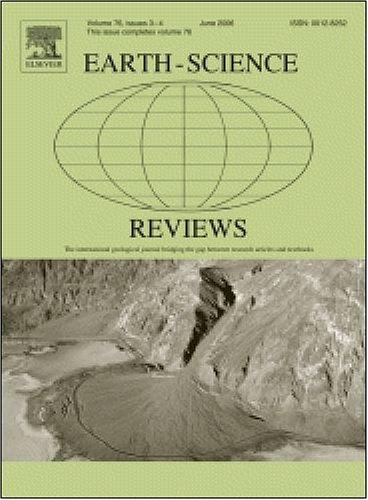The precursor of apatite: Octacalcium phosphate (OCP) in the earth and environmental sciences - A review
IF 10.8
1区 地球科学
Q1 GEOSCIENCES, MULTIDISCIPLINARY
引用次数: 0
Abstract
Octacalcium phosphate (OCP) is a solid phase that is well known in the biomedical field because it is widely used and tested as a precursor to bioapatite to treat various diseases affecting bones and teeth. In contrast, the knowledge of OCP in the earth sciences and its actual and possible applications in the environmental field are much less well known. With this review, we aim to fill this gap by showing that OCP is a much more widespread phase than is thought in various geological systems, and its properties allow its effective use in the environmental field, especially when it is used in the removal of various contaminants from wastewater and drinking water. This review not only lists the occurrences of OCP in nature or its uses in the environmental field but also proposes a critical analysis of the literature. In particular, a thorough examination of the failure to recognize OCP in numerous studies has highlighted the importance of performing low-angle XRD measurements in order to achieve proper identification of calcium phosphate minerals. A useful analytical protocol for recognizing and distinguishing OCP from similar phases such as those in the apatite group is suggested. Finally, we propose that OCP be recognized as a natural mineral species by the International Mineralogical Association-Commission on New Minerals Nomenclature and Classification (IMA-CNMNC). Such recognition, in our opinion, would provide a renewed and stimulating impetus to studies on the geochemical and mineralogical cycle of phosphorus.
磷灰石的前体:磷酸八钙(OCP)在地球与环境科学中的研究进展
八磷酸钙(OCP)是一种在生物医学领域众所周知的固相,因为它被广泛用作生物磷灰石的前体,并被测试用于治疗影响骨骼和牙齿的各种疾病。相比之下,地球科学中的OCP知识及其在环境领域的实际和可能的应用则鲜为人知。通过这篇综述,我们的目标是填补这一空白,表明OCP在各种地质系统中比想象的要广泛得多,它的性质允许它在环境领域得到有效利用,特别是当它用于去除废水和饮用水中的各种污染物时。本文不仅列举了OCP在自然界中的出现情况及其在环境领域中的应用,而且还提出了对文献的批判性分析。特别是,对许多研究中未能识别OCP的彻底检查强调了进行低角度XRD测量以实现正确识别磷酸钙矿物的重要性。提出了一种识别和区分OCP与类似相(如磷灰石组)的有效分析方案。最后,我们建议OCP被国际矿物学协会-新矿物命名与分类委员会(IMA-CNMNC)认定为天然矿物。我们认为,这种认识将为研究磷的地球化学和矿物学循环提供新的和令人振奋的动力。
本文章由计算机程序翻译,如有差异,请以英文原文为准。
求助全文
约1分钟内获得全文
求助全文
来源期刊

Earth-Science Reviews
地学-地球科学综合
CiteScore
21.70
自引率
5.80%
发文量
294
审稿时长
15.1 weeks
期刊介绍:
Covering a much wider field than the usual specialist journals, Earth Science Reviews publishes review articles dealing with all aspects of Earth Sciences, and is an important vehicle for allowing readers to see their particular interest related to the Earth Sciences as a whole.
 求助内容:
求助内容: 应助结果提醒方式:
应助结果提醒方式:


